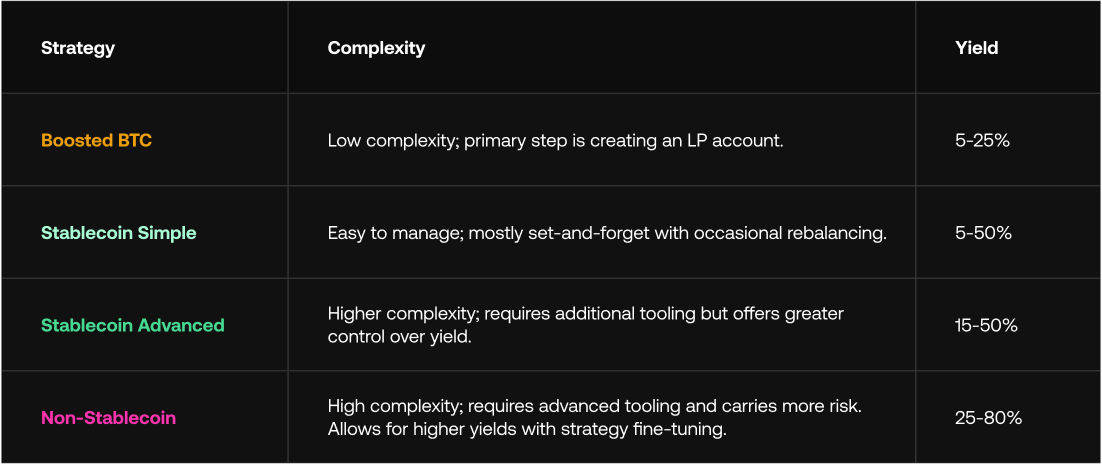Chainflip Liquidity Provision: Strategies and Risks

TL;DR
Chainflip offers unique opportunities for liquidity providers (LPs) to generate yield by providing liquidity on-chain through innovative strategies. This guide covers how Chainflip’s Just-In-Time (JIT) AMM model works, its yield opportunities, and various strategies for earning yield on BTC, stablecoins, and non-stablecoins, each with different levels of complexity and yield potential.
Chainflip Liquidity Provision: Unlocking Yield Opportunities for LPs in DeFi
Chainflip offers unique yield opportunities for liquidity providers (LPs), with returns comparable, if not better, than those achieved by professional market makers in traditional finance and DeFi.
At the core of Chainflip’s design is its innovative Just-In-Time (JIT) AMM model, which operates similarly to an order book strategy. By placing limit orders and utilising just-in-time liquidity, Chainflip allows LPs and market makers to anticipate incoming swaps and compete to provide the best execution price—similar to a Request for Quote (RFQ) or intent-based system.
This setup opens new doors for yield generation, including for assets like native BTC, which traditionally lack DeFi support. In addition, Chainflip incorporates range orders, providing LPs with the flexibility to choose their strategy based on market conditions and personal risk tolerance.
This guide explores the diverse opportunities Chainflip offers liquidity providers, helping you find the best fit based on your goals and risk profile.
Liquidity Provision Opportunities on Chainflip
Chainflip supports a range of strategies for LPs, each with different levels of complexity and yield potential. Below is an overview of the available strategies, their complexity, and expected yields. Let’s explore each opportunity in more detail.

Boost Pools to Earn Yield on Bitcoin
For LPs seeking a straightforward strategy, the Boost Pool offers an easy way to earn yield on native BTC. Simply create an LP account, deposit BTC into the boost pool, and start earning.
Boost yields vary depending on the volume of Bitcoin transactions processed by Chainflip and the number of users choosing to boost. High-volume days can drive significant boosts to yields. Below is a summary of recent boost yields and transaction volumes over the last month.

Yields depend on the total boost liquidity in the pool, the generated volume, and your share in the pool. At its peak last month, boost yields reached up to 105%—all in native BTC, with no risk of impermanent loss.
Stablecoin Liquidity Provision
Providing liquidity for stablecoins on Chainflip can range from a straightforward approach to a more hands-on method. Currently, the most active stablecoin pairs are USDC, USDT, solUSDC, and arbUSDC, each offering unique yield opportunities.
The Simple Approach: Place a range order for the stablecoins you wish to provide. Stablecoins experience minimal price fluctuation, allowing you to stay competitive on pricing without frequent adjustments. This approach provides passive yield generation with minimal upkeep.
The Hands-on Approach: This strategy involves manually placing limit orders at specific price points, requiring more active management. Once an order is filled, you’ll need to replace it on the order book. This method offers flexibility, allowing you to set precise prices and maximise yields. However, If you’re unavailable to manage orders, you may miss out on incoming volume.
To support this approach, community members have developed tools to make the process more passive. One such tool is a stablecoin liquidity provision bot, allowing you to run your LP account autonomously. Details on this bot can be found in our Liquidity Provision Telegram group.
Non-Stablecoin Strategies
This strategy isn’t for the faint-hearted, but it offers the highest potential yield for those willing to dive in. As the most advanced approach, it provides complete flexibility to execute orders on Chainflip at custom margins, making it ideal for LPs looking to implement market-making strategies similar to those used by funds.
This hands-on strategy requires active management and frequent rebalancing to maximise yield. The most commonly traded assets here are BTC, ETH, and SOL.
The process is straightforward in principle: connect your LP account to Chainflip’s API, then set up a system for automatic order placement on Chainflip, adjusting positions based on external price movements for each asset. Once an order is filled, you may need to hedge that position on another exchange to remain delta-neutral—or skip this step if you’re comfortable with exposure.
Non-stablecoin LPs earn yield by capturing maker fees and profiting from the spread between Chainflip prices and external hedging exchange prices. This approach allows for highly customizable yields and margins. To dive deeper into delta-neutral market-making strategies, check out this comprehensive guide here.
While this strategy can seem intimidating, the yield potential speaks for itself. Many community members have transitioned to non-stablecoin liquidity provision and are seeing yields as high as 80%. Take Chainflipgod, for example—a top liquidity provider who started with no coding experience and quickly set up a bot to automate their strategy. To make things easier, Chainflipgod has open-sourced a sample script for setting up a bot here, so you can quickly pick up the essentials.
The best part? This strategy is highly scalable. More liquidity drives more volume, leading to tighter pricing and even higher yields. If you’re interested in learning more, join our Liquidity Provision Telegram chat, where we’ll help you get started!
Understanding the risks with Liquidity Provision on Chainflip
While Chainflip offers compelling yield opportunities, liquidity providers should be aware of the associated risks common in DeFi. In this section, we outline potential risk and how Chainflip’s design and strategies mitigate each risk:
Impermanent Loss (IL)
Impermanent loss occurs when asset prices fluctuate significantly in AMMs. Chainflip mitigates this by using USDC as the base pair, allowing LPs to hedge more effectively and reduce IL risk. USD-pegged pairs also enable liquidity aggregation and easier hedging, to support market-neutral strategies for LPs.
Slippage and Front-Running
Slippage and front-running are risks in traditional AMMs, where trades may incur hidden costs and price shifts. Chainflip’s JIT AMM design mitigates these risks by:
- Bundling swaps for bulk execution, which prevents front-running and stabilises quotes.
- Executing sales before buys in each block to reduce slippage.
- Encouraging LP competition to offer the best quotes, reducing value extraction.
This setup ensures efficient price discovery delivering a better experience for LPs overall.
Boost Pool-Specific Risks
Boosting BTC enhances swap speed but comes with specific risks for BTC swaps, such as:
Chain Reorganisation: Although reorgs on the Bitcoin network are rare, Chainflip mitigates this with confirmation windows to only accept finalised transactions. More details here.
Coding Knowledge for Running a Bot
For LPs using more complex strategies, coding knowledge is helpful for managing and running Chainflip’s tools. Running bots to automate non-stablecoin and advanced stablecoin strategies requires:
- Accurate bot setup and configuration to prevent potential losses.
- Continuous monitoring to detect any code errors, with resources available through Chainflip’s community for support.
Rebalancing Risks
Rebalancing can be challenging in one-directional flow situations, especially for smaller portfolios. Rebalancing less frequently reduces costs through economies of scale, which can make larger portfolios more cost-effective in managing rebalancing. Although active strategies require more hands-on management, they offer higher yield potential for LPs.
Smart Contract Vulnerabilities
Smart contract vulnerabilities are a well-known risk in DeFi, where coding flaws can lead to exploits. Chainflip minimises this risk by using the Substrate framework, which allows for forkless upgrades and pallet-based modules written in Rust. This design reduces miner extractable value (MEV) risks and enhances security by integrating Chainflip’s JIT AMM directly with the State chain’s runtime.
Protocol Risk
Chainflip’s built-in protections address protocol risks like governance attacks, supermajority control, and chain reorganisation:
- Governance Security: A rotating key structure and cooldown period allow LPs to respond to protocol changes.
- Supermajority Control: Validators enforce collateral requirements, preventing profitable collusion and securing pooled funds.
- Chain Reorganisation: Chainflip minimises reorg risk with confirmation windows and validator consensus, processing only finalised transactions.
For a more detailed look at Chainflip’s protocol safeguards, check out our documentation.
Take the Next Step with Chainflip’s Liquidity Opportunities
Chainflip offers a wide array of innovative yield-generating strategies, designed not only to facilitate swaps but also to empower liquidity providers with tools for strategic, active participation. Whether you’re looking for simplicity or advanced control, Chainflip equips you with the flexibility to tailor your approach and maximise your potential in the cross-chain ecosystem.
This guide is just the beginning. Next time, we’ll explore the potential risks of liquidity provision to give you a balanced view of the opportunities available. Until then, if you’re ready to learn more or need guidance, connect with us on our socials! Our community is here to support you—join us in the Liquidity Provision Telegram chat or on Discord for insights, tips, and a welcoming space to help you succeed.
FAQ: Chainflip Liquidity Provision
What is Chainflip’s AMM and how does it differ from other DeFi protocols?
Chainflip’s AMM uses a Just-In-Time (JIT) model with order book strategies, enabling LPs to earn yield by placing limit orders and providing liquidity only when needed.
How can I earn yield on Chainflip with native BTC?
By joining Chainflip’s Boost Pool, LPs can earn yield on native BTC with no impermanent loss.
Are Chainflip’s stablecoin liquidity options passive?
Yes, Chainflip offers both passive and more hands-on stablecoin LP strategies, depending on user preference and experience.
What is impermanent loss, and how does Chainflip mitigate it?
Impermanent loss (IL) is a potential risk in AMMs when asset prices fluctuate significantly. Chainflip mitigates IL by using USDC as the base pair, allowing LPs to hedge more easily and minimise IL exposure through market-neutral strategies.
How does Chainflip address slippage and front-running risks?
Chainflip’s JIT AMM design reduces slippage and front-running by bundling swaps for bulk execution, stabilising quotes, and setting a predetermined execution order. This efficient setup promotes fair pricing and discourages value extraction.
Are there specific risks for LPs using the Boost Pool?
Yes, Boost Pools carry specific risks, like chain reorganisation on Bitcoin and channel expiry. Chainflip mitigates reorg risks by confirming transactions only

